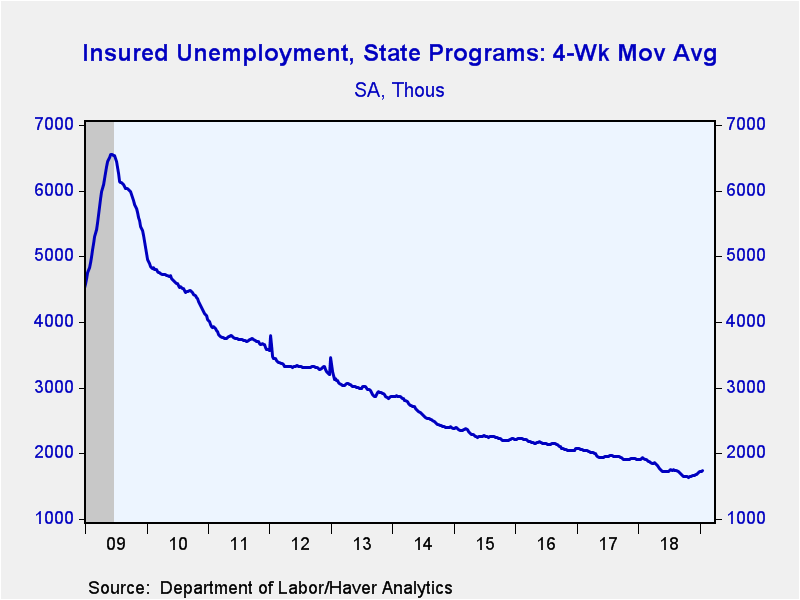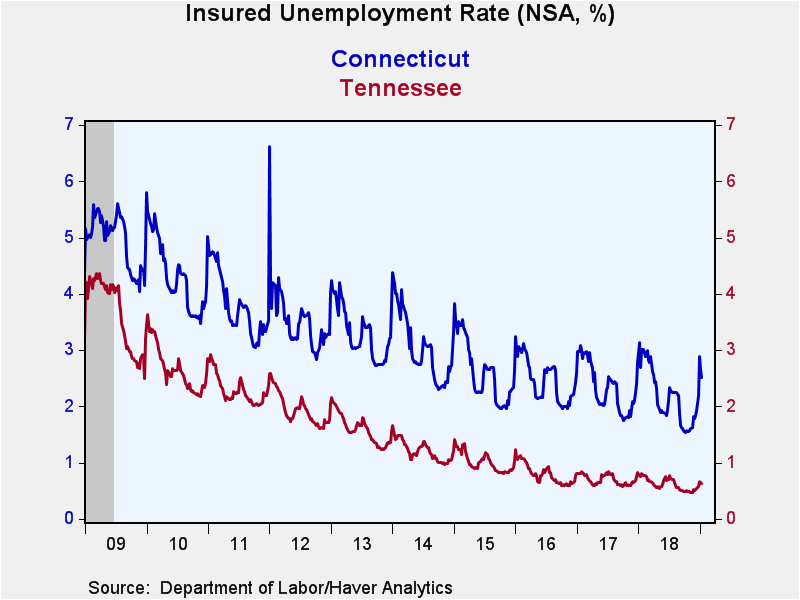 Global| Jan 31 2019
Global| Jan 31 2019U.S. Initial Unemployment Insurance Claims Jump to 253,000
Summary
Initial claims for jobless insurance jumped unexpectedly to 253,000 in week ended January 26 from 200,000 in the week before; that earlier number was revised up by 1,000. This latest is the largest number of claims since September 30, [...]
Initial claims for jobless insurance jumped unexpectedly to 253,000 in week ended January 26 from 200,000 in the week before; that earlier number was revised up by 1,000. This latest is the largest number of claims since September 30, 2017. The Action Economics Forecast Survey expected 212,000 claims this week, and the highest forecast was 225,000. The four-week moving average rose to 220,250 from 215,250.
Continuing claims for unemployment insurance also increased markedly, reaching 1.782 million in the week ended January 19 from 1.713 million the previous week. The four-week moving average of continuing claims increased to 1.738 million from 1.729 million. This is the highest reading since April 28, 2018, when it was 1.794 million.
The insured unemployment rate held steady at 1.2% in the week ended January 19, after hitting a record low of 1.1% during last October and November. The figure compares the number of people receiving benefits to the number of employees covered by unemployment insurance.
Press reports note that it's possible that a quirk in seasonal patterns, perhaps associated with the late date for the Martin Luther King holiday may have affected the latest initial claims data. Not seasonally adjusted, the number of initial claims fell from 269,757 in the January 19 week to 250,188 in the January 26 week, which was noticeably lower than the 267,766 claims filed in the year-ago week.
As we highlighted last week, the headline data on unemployment insurance claims cover the state-run programs, and these do not involve federal government employees impacted by the government shutdown. They have their own program, and in the latest information on this published by the Labor Department, 14,739 federal employees filed for unemployment insurance in the week ended January 19; this is a decrease from 25,419 the week before. All together, 40,112 federal workers were receiving unemployment insurance in the week ended January 12, up from 24,681 in the January 5 week. In comparison, a year ago, just 1,004 federal workers filed claims and 11,817 were receiving benefits. Further, when furloughed employees return to work, they must repay any unemployment insurance benefits they have collected. The government shutdown also affected government contractors, and their employees would be included in the state-run programs cited above.
Insured unemployment rates vary widely by state. These state data are not seasonally adjusted, so, not surprisingly, the very lowest rates are found in the South: during the week ending January 12, the lowest rates were in Florida (0.46%), North Carolina (0.47%), Tennessee (0.63%) and Virginia (0.65%), with Indiana (0.66%). The highest rates were in Alaska (3.43%), New Jersey (2.67%), Rhode Island (2.53%), Connecticut (2.52%) and Montana (2.41%).
Data on weekly unemployment claims going back to 1967 are contained in Haver's WEEKLY database and are summarized monthly in USECON. Data for individual states are in REGIONW. The expectations figure is from the Action Economics Forecast Survey, carried in the AS1REPNA database.
| Unemployment Insurance (SA, 000s) | 01/26/19 | 01/19/19 | 01/12/19 | Y/Y % | 2018 | 2017 | 2016 |
|---|---|---|---|---|---|---|---|
| Initial Claims | 253 | 200 | 212 | 8.1 | 221 | 244 | 262 |
| Continuing Claims | -- | 1,782 | 1,713 | -8.1 | 1,766 | 1,967 | 2,135 |
| Insured Unemployment Rate (%) | -- | 1.2 | 1.2 |
1.4 |
1.2 | 1.4 | 1.6 |
Carol Stone, CBE
AuthorMore in Author Profile »Carol Stone, CBE came to Haver Analytics in 2003 following more than 35 years as a financial market economist at major Wall Street financial institutions, most especially Merrill Lynch and Nomura Securities. She has broad experience in analysis and forecasting of flow-of-funds accounts, the federal budget and Federal Reserve operations. At Nomura Securites, among other duties, she developed various indicator forecasting tools and edited a daily global publication produced in London and New York for readers in Tokyo. At Haver Analytics, Carol is a member of the Research Department, aiding database managers with research and documentation efforts, as well as posting commentary on select economic reports. In addition, she conducts Ways-of-the-World, a blog on economic issues for an Episcopal-Church-affiliated website, The Geranium Farm. During her career, Carol served as an officer of the Money Marketeers and the Downtown Economists Club. She has a PhD from NYU's Stern School of Business. She lives in Brooklyn, New York, and has a weekend home on Long Island.









